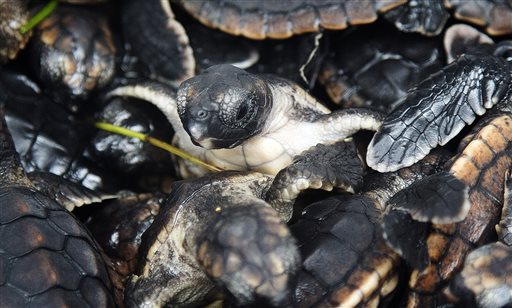 A young loggerhead turtle crawls through a pile of others waiting to be released Thursday, Sept. 5, 2013, into the Altantic Ocean near Boca Raton, Fla. Coast Guard officials helped Melanie Stadler, a marine scientist with Gumbo Limbo Nature Center, release almost 500 sea turtle hatchlings into the Atlantic Ocean.
A young loggerhead turtle crawls through a pile of others waiting to be released Thursday, Sept. 5, 2013, into the Altantic Ocean near Boca Raton, Fla. Coast Guard officials helped Melanie Stadler, a marine scientist with Gumbo Limbo Nature Center, release almost 500 sea turtle hatchlings into the Atlantic Ocean.BOCA RATON, Fla. - More than 500 sea turtle hatchlings were gently released by hand Thursday onto sea beds off Florida's Atlantic Coast, where the turtles have a better chance to survive.
The U.S. Coast Guard assisted with the release about six miles off the coast of Boca Raton because it is committed to protecting endangered and threatened species, officials said in a statement.
"I'm very passionate about the environment," said Chief Cannon Schider-Heisel with the U.S. Coast Guard. "And my job affords me the chance to do that sometimes, where I get to help educate the public about the environment. It's a facet of my job that I love."
Schider-Heisel, who volunteers at the Gumbo Limbo Nature Center, where the hatchlings were collected, joined marine scientist Melanie Stadler and other turtle rescue volunteers to release 311 loggerhead and 194 green sea turtles on Thursday.
One by one, the turtles were slowly placed in the water and onto beds of seaweed where "they have more hope to survive," said Schider-Heisel, who described the sea beds as a La-Z-Boy for the baby turtles, or a safe and comfortable place for them to be released.
The hatchlings, some as young as two days old, came from turtle nests from beaches throughout Florida where the loggerhead, leatherback and green turtles nest regularly. Two other species also nest in Florida in very small numbers, the Kemp's ridley and hawksbill.
The loggerhead is threatened and the green and leatherback are endangered, but all sea turtles are federally protected. It is against the law to touch or disturb nesting sea turtles, hatchlings or their nests. Signs are posted on beaches during nesting season, as adult females emerge to nest on the beach mostly at night. The hatchlings also emerge from their nests mostly at night. Only about one in 1,000 baby turtles survive to adulthood.
"A lot of these I literally pulled out of a nest," said Stadler as she held a baby turtle in her hand to show a Coast Guard crew member. "I have a connection with a lot of them, as do the rest of the turtle specialists. We all rescue these little guys every morning and knowing that we get to release them and they are healthy and ready to go is pretty awesome."
Stadler said the Coast Guard's assistance with transporting so many baby sea turtles at once was "crucial" for their survival.
Florida's nesting season runs from March through October on the Atlantic coast, and from May through October on the Gulf Coast.